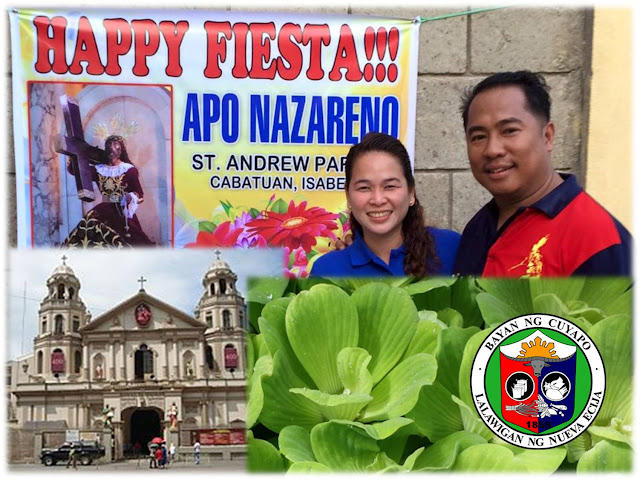14. PISTIA STRATIOTES’ NAZARENO
PISTIA STRATIOTES’ NAZARENO
Dr. Troy Alexander G. Miano
During my early teenage years, I would regularly take trips to places all alone to experience being “independent” and to check on my “diskarte” (one’s effective way of doing things). I remember when my dad regularly tagged me along Quiapo District in Manila to buy supplies and parts for the manufacture of fire extinguishers which was our family’s means of livelihood. One sunny day, I decided to visit Quiapo by myself and descended at Quiapo Church.
Outside the Roman Catholic Church, I
saw the historical marker issued by the Philippine Historical Committee in 1939
which reads: “Governor General Santiago
De Vera founded the District of Quiapo August 29, 1586. Franciscan missionaries
build the first church of bamboo and nipa that was burned in 1639. Rebuilding
and repair as intervals gave the parish the strongest edifice that the
earthquake of 1863 partially destroyed. The next church, completed in 1899, was
the work of Rev. Eusebio De Leon and Rev. Manuel Roxas, the latter raising
P40,000.00 in contributions. A fire on October 30, 1929, left the church only
its scarred walls and belfry, and a parish committee headed by Doña Encarnacion
Nakpil de Orense raised the funds for its reconstruction. Juan F. Nakpil,
architect, drafted the plans for the reconstructed building. A famous image of
Christ bearing the cross, called the Nazarene is the center of intense Friday
devotions throughout the year”.
Quiapo District derives its name from the water
cabbage, scientifically named Pistia stratiotes, which is termed as kiapo in the Tagalog language. According to Medical Entomology for Students by CTI Reviews, Pistia is a genus of aquatic plant in the arum family, Araceae. The single species
it comprises, Pistia stratiotes, is often called water cabbage, water lettuce, Nile cabbage, or shellflower. Its native distribution
is uncertain, but probably pantropical. It was first
discovered from the Nile near Lake Victoria in Africa. It is now present,
either naturally or through human introduction, in nearly all tropical and
subtropical fresh waterways. The genus name is derived from the Greek word pistos, meaning "water," and refers to
the aquatic nature of the plants.
Another local government unit derives its name from the Pistia stratiotes – the
Municipality of Cuyapo in Nueva Ecija province. According to the Kulantong, or Cronologia
written by Cirilo R. Sumangil, a native of Cuyapo, who, for over forty years,
was the Parish Priest of the Philippine Independent Church of Cuyapo, the name
comes from the Pangasinan word “kuyapo”, “kiapo” or “quiapo” in Tagalog (“lul-luan”
in Ilocano), a water plant that looks like a flower. The said aquatic plant was
so abundant particularly in a place which is now owned by the Monteros,
situated along Rizal Street near the Municipal Cemetery. It was at this place
that lured cow tenders
and foresters from Paniqui in Tarlac, Sta. Maria and Narvacan in Ilocos Sur; Paoay and Batac in Ilocos
Norte; and Calasiao and San Carlos in Pangasinan, to settle in great numbers in the town.
Cuyapo was declared a Barrio of Rosales, Nueva Ecija (Rosales became part of
Pangasinan only in 1901) on September 25, 1849. On October 29, 1859, Cuyapo was
separated from the old town of Rosales and made a regular town.
Quiapo’s
Black Nazarene is a life-sized image of a dark-skinned Jesus Christ carrying the Cross enshrined in the Minor Basilica of the Black Nazarene. According to the Religious Celebrations: An
Encyclopedia of Holidays, Festivals, Solemn Observances, and Spiritual
Commemorations by
J. Gordon Melton published in 2011, the icon was carved from a dark wood
in the 16th century in Mexico and then transported to Philippines in 1606. It depicts Jesus en route to his
crucifixion. Pope Innocent X granted recognition to the lay
Confraternity of Santo Cristo Jesús Nazareno in 1650 for the promotion of the
devotion to Jesus through the icon. It
was housed in several churches near Manila in the early decades, arriving in
Quiapo Church in 1787 where it has been enshrined ever since. The icon is renowned in the
Philippines, and is considered by many Filipino
Catholics to
be miraculous, its mere touch able to cure disease. It attracts homage by numerous
devotees and major processions every year. The image (in recent years a
composite replica) is brought out of its shrine for public veneration three
times a year: January 9, Good Friday (the Nazarene's "actual"
feast, commemorating the culmination of the Passion), and December 31 (New Year's Eve,
the first day of the novena). The
January 9 procession re-enacts the image's Traslación (literally, "transfer") in
1787, or "solemn transfer" to the Minor Basilica from its original
shrine inside Intramuros a blessed copy of the original image. The January 9 Traslación is the largest procession, drawing
millions of devotees thronging to touch the icon, and lasting 20 hours at the average.
The Black Nazarene, also known
in Spanish as El
Nazareno Negro, Nuestro Padre Jesús Nazareno and in Filipino as Poóng
Itím na Nazareno, Hesus Nazaren, is
venerated by devotees every Friday, and along with the Santo Niño (Child Jesus), is the
most popular object of devotion in the Philippines.
I am not a long time Nazareno devotee but ever since the feast day was
observed in Cabatuan, Isabela, I try my best to save time to be a part of the
event. Almost everybody knows the place Quiapo even if majority of Filipinos
have not been in Manila’s most busy district. Culminating my visit in the area,
I would always have merienda of fresh
spring roll at the famous Globe Lumpia House in Raon Street. Pistia stratiotes became popular not only as an ornamental plant seen in different
gardens in the metropolis and in the countryside but because its local name Quiapo
became the center of trade and commerce of the “Old Downtown of Manila.”




Mga Komento
Mag-post ng isang Komento